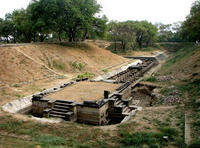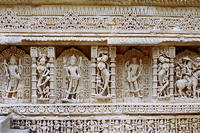You are in: Asia -> India -> Rani-ki-Vav (the Que... , and traditional search or Image Gallery will yield results of this site only
Rani-ki-Vav (the Queen’s Stepwell) at Patan, Gujarat
| Site number: | 922 |
|
| Type of site: | Cultural | |
| Date: | 11th century | |
| Date of Inscription: | 2014 | |
| Location: | Asia, India, Patan, Gujarat | |
Up to 75 images are shown here. Click on each for more details or on Image Gallery for more images.
| Description: | Rani-ki-Vav, on the banks of the Saraswati River, was initially built as a memorial to a king in the 11th century AD. Stepwells are a distinctive form of subterranean water resource and storage systems on the Indian subcontinent, and have been constructed since the 3rd millennium BC. They evolved over time from what was basically a pit in sandy soil towards elaborate multi-storey works of art and architecture. Rani-ki-Vav was built at the height of craftsmens’ ability in stepwell construction and the Maru-Gurjara architectural style, reflecting mastery of this complex technique and great beauty of detail and proportions. Designed as an inverted temple highlighting the sanctity of water, it is divided into seven levels of stairs with sculptural panels of high artistic quality; more than 500 principle sculptures and over a thousand minor ones combine religious, mythological and secular imagery, often referencing literary works. The fourth level is the deepest and leads into a rectangular tank 9.5 m by 9.4 m, at a depth of 23 m. The well is located at the westernmost end of the property and consists of a shaft 10 m in diameter and 30 m deep. --From the description at WHC Site, where additional information is available. | |
| Rani ki vav is an intricately constructed stepwell situated in the town of Patan in Gujarat, India. It was included in the list of UNESCO's World Heritage Site on 22 June 2014. Rani ki vav, or Ran-ki vav (Queen’s step well) was constructed during the period of the Solanki or Chalukya. It is a richly sculptured monument. It is generally assumed that it was built in the memory of Bhimdev I (AD 1022 to 1063), the son of Mularaja, the founder of the Solanki dynasty of Anahilwada Pattan about 1050 AD by his widowed queen Udayamati and probably completed by Udayamati and Karandev I after his death. A reference to the Udayamati building the monument is in the 'Prabandha Chintamani' composed by Merunga Suri in 1304 AD. This magnificent east facing step well measures approximately 64m long, 20m wide & 27m deep. A stepped corridor compartmented at regular intervals with pillared multi-storeyed pavilions is a unique feature. It was one of the largest and the most sumptuous structures of its type. It became silted up and much of it is not visible now, except for some rows of sculptured panels in the circular part of the well. Among its ruins one pillar still stands which is the proof not only of the elegance of its design, but also excellent example of this period. A part only of the west well is extant from which it appears that the wall had been built of brick and faced with stone. From this wall project vertical bracket in pairs, this supported the different galleries of the well shaft proper. This bracketing is arranged in tiers and is richly carved. The minute and exquisite carving of this vav is one of the finest specimens of its kind. Befitting its name, the Rani-Ki-Vav is now considered to be the queen among step wells of India. There is also a small Gate below the last step of the step well which has a 30 kilometre tunnel built (Now it has been blocked by stones and mud) which leads to the town of Sidhpur near Patan. It was used as an escape gateway for king who built the step well in the times of defeat. Most of the sculptures are in devotion to Vishnu, in the forms of Dus-Avatars Kalki, Rama, Mahisasurmardini, Narsinh, Vaman, Varahi and others representing their return to the world. Nagkanya, Yogini beautiful women - Apsara showcasing 16 different styles of make-up to look more attractive called Solah-shringar --Wikipedia. Text is available under the Creative Commons Attribution-ShareAlike License. | ||
| Source: | http://whc.unesco.org/en/list/922 | |
| Source2: | Wikipedia (http://wikipedia.com) | |
| Reference: | 1. UNESCO World Heritage Center (http://whc.unesco.org/en/list/922). 2. Wikipedia. | |




















